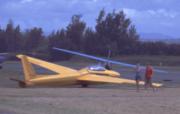
Treasure Hunt #3
Note: At this time there is a four-way tie for first place in our
$500 cash prize. All four have answered three questions correctly so far.
Winner: Keith Douglas Craig
Winner was drawn at random from 5 correct respondents. Drawing performed
by Dottie Morrison in Lanikai, Oahu, HI, the morning of May 22.
Answers were due by midnight, May 21, 2001
Awarded prize:
30 minutes of dual glider instruction at Honolulu Soaring
Honolulu Soaring is located at Dillingham Airfield and can offer instruction
in some of the most reliable lift to be found anywhere on earth (provided
you choose a day with trade winds for your flight). Take to the sky in
a SGS-2-33 for your lesson. Get checked out and try a SGS-1-26. Honolulu
Soaring's web page is www.honolulusoaring.com
and their phone number is (808) 677-3404.
This week's Question: A supersonic jet aircraft takes off from
an airport on the equator near sunset and heads west. The pilot levels
the plane in cruise flight and notices that only the tip of the sun is
visible above the horizon. What groundspeed must the pilot maintain in
order to keep the sun in it's relative position on the horizon (disregarding
mountain peaks and other incidental bumps)?
The answer is easier than it might first
appear. Think about it. If your answer is within 5% of the correct answer
we will consider you to have correctly answered this question.
Hint: For the circumference of the earth,
click on the "Messages" button, and go to "hints"
under the topic "$1500 treasure hunt".
Answer:
Our hint lists the circumference of the earth at the equator as 25,000
miles. It takes 24 hours for the sun to make one complete revolution.
Therefore, one must fly fast enough to circle the globe in 24 hours in
order to glue the sun to the horizon. Take 25,000 miles, divide by 24
hours, and you get approx. 1041 mph.
One respondent factored in the approximate
altitude of the jet and figured that this altitude increase the required
groundspeed by 3 mph. Another variable is that from sunset of one day
to sunset of the next day, there might be slightly more or less than 24
hours of time elapse (change of season). However, none of these issues
influence the correct answer anywhere near the 5% buffer allowed in the
answer. Therefore, if you answered with 5% of the figure 1041 mph, you
received credit for a correct answer.